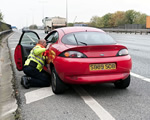 Go to main content
Go to main content
Archive Website of the UK government
Please note that this website has a UK government accesskeys system.
Main menu
Page menu
Travel and transport

What to do if you break down on the motorway

Always plan your journey and make sure you have enough fuel before you join the motorway. If you do break down, follow these safety tips to reduce the risk to yourself and other drivers.
Don't stop unless you have to
If you need to stop in an emergency you should pull onto the hard shoulder.
The motorway hard shoulder can be a dangerous place and is illegal to stop there unless it is an emergency. You should never stop there to read a map, go to the toilet or answer the phone - always drive to the next services or exit.
Stay safe while you are on the hard shoulder
If a breakdown or other emergency forces you to stop, then follow the Highways Agency's top five safety tips.
Pull over to the left
Pull over onto the hard shoulder and park as far to the left as possible, near an emergency roadside phone if you can. Turn on your vehicle's hazard warning lights.
Leave your vehicle
Leave your vehicle immediately via the left-hand door. Make sure your passengers do the same. You should leave any animals in the vehicle, or keep them under proper control on the verge.
Contact the Highways Agency
Use the nearest emergency roadside phone rather than a mobile phone if possible. If you use an emergency roadside phone your exact location will show on the operator's screen and it will be easier to find you. On motorways these phones are spaced at one-mile intervals.
Roadside markers (pictured below) are spaced at 10-metre intervals on the hard shoulder. They show how far you are in kilometres from the start of the motorway. They also show the direction of the nearest emergency phone that you can safely use.
Wait for help to arrive
Stay well away from the carriageway and hard shoulder as you wait for help to arrive. Don't get back into the vehicle and don't try to repair your car yourself, even if you think it's a simple job.
If you feel at risk from another person
If you think you are in danger, return to your vehicle via the left-hand door, fasten your seatbelt and lock all doors. Leave the vehicle as soon as you feel the risk has passed.
If you can't get to a roadside phone
Roadside markers

Roadside markers show your exact location and the direction of the nearest emergency phone
If you're injured or have a disability that means you can't get to a roadside phone, the Highway Code advises you to:
- stay in the vehicle with your seat belt on
- switch on your hazard warning lights
If you have a mobile phone you should dial 999 and tell the emergency services where you are. If you can see a roadside marker or driver location sign, tell the operator what it says as this will help them find you.
You can find detailed information on driver location signs by following the link below.
More information for disabled road users
The Highways Agency produces a magazine for disabled road users called 'My way'. It contains general driving advice and detailed information on what to do in an emergency. You can download a copy by following the link below. You can also order a printed version by calling the Highways Agency information line on 0300 123 5000.
Additional links
Simpler, Clearer, Faster

From 17 October, GOV.UK will be the best place to find government services and information
 Facebook
Facebook Twitter
Twitter StumbleUpon
StumbleUpon Delicious
Delicious Reddit
Reddit
